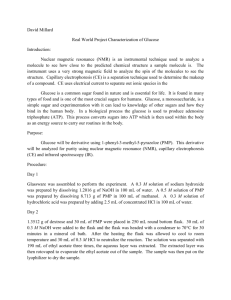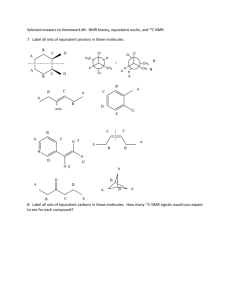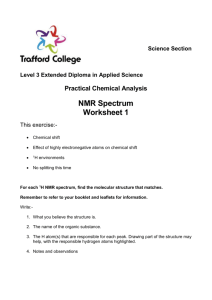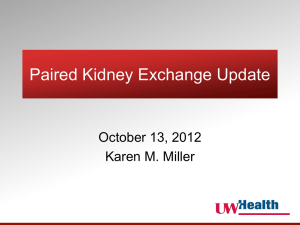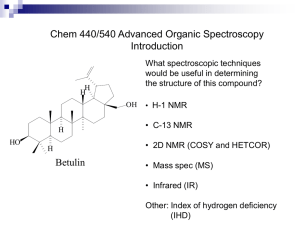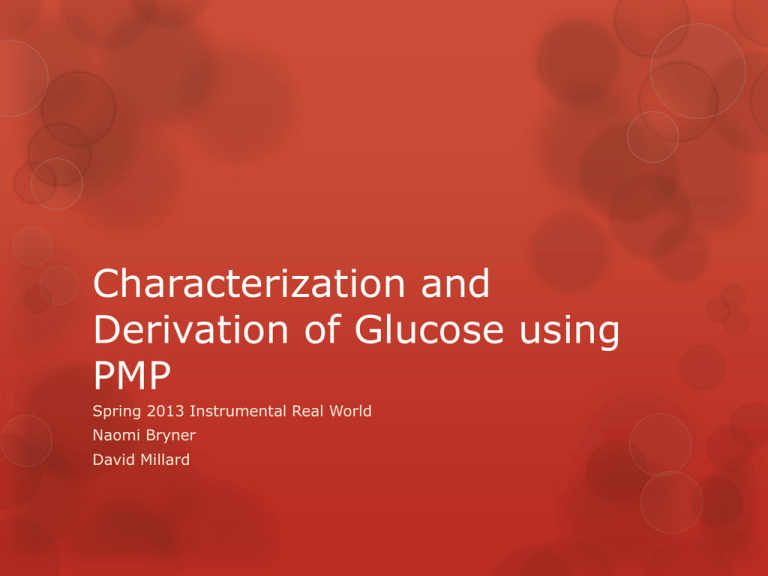
Characterization and
Derivation of Glucose using
PMP
Spring 2013 Instrumental Real World
Naomi Bryner
David Millard
Background
Glucose, most common sugar and essential for life.
Simple sugar and can lead to further knowledge of more
complex sugars.
Critical in the production of adenosine triphosphate
(ATP).
ATP is the energy source used throughout the body.
Product analyzed with nuclear magnetic resonance
(NMR) and capillary electrophoresis (CE) and infrared
spectroscopy (IR).
Method - Derivatization
Created stock solutions of NaOH (0.3 M), PMP in MeOH (0.5 M), HCl
(0.3 M) and a sodium borate buffer (0.2 M, 9.5 pH).
Dextrose (1.3512 g) added to RBF with NaOH (30 mL) and PMP (30
mL), heated in mineral oil bath with condenser at ~70°C for 30 min.
HCl (30 mL) added after cooling to neutralize reaction.
Method – Extraction, Isolation &
Analysis
Sample and ethyl acetate (190 mL) added to separatory
funnel for extract (x 3).
Aqueous layer evaporated to dryness
Rotory evaporator for ethyl acetate, methanol
Lyophilizer for water
After sample was dried, water was added to dissolve
sample, followed by another round of evaporation to
dryness.
Product was analyzed with NMR, CE, and IR.
Data - CE
PMP peak
Product peak
Data - IR
Data - Proton NMR
Theoretical
Spectrum
Experimental
Spectrum
Data –
Theoretical
Spectrum
Resultant
Spectrum
13C
NMR
Results
Stock glucose can’t be examined directly; lack of
chromophores.
13C
NMR: noisy baseline led to an increase of scans from
1024 to 7500 (overnight).
CE was comparison of PMP to product, NMR and IR were
characterization.
Technological advancements caused difficulty in method
replication (2002 -> 2013).
Week-long derivatization and tedious product isolation
was worthwhile.
Ketone, permanent aspect of PMP in MeOH, was not
detected in IR analysis, indicative of a product without
excess PMP.
References
Bruice, P. Y. In Organic Chemistry; Folchetti, N.,
Mullaney, R., Kaveney, D., Eds.; Pearson prentice Hall:
Upper Saddle River, NJ, 2007, 5th Edition, pp 418-460.
Thibault, Pierre, and Susumu Honda. Capillary
electrophoresis of carbohydrates. Totowa, NJ: Humana,
2002
Special Thanks to:
Dr. Foy, Dr. Hu, Dr. Halligan, Amanda MacPhearson, Jesse
Diehl, Delaney Caudill

